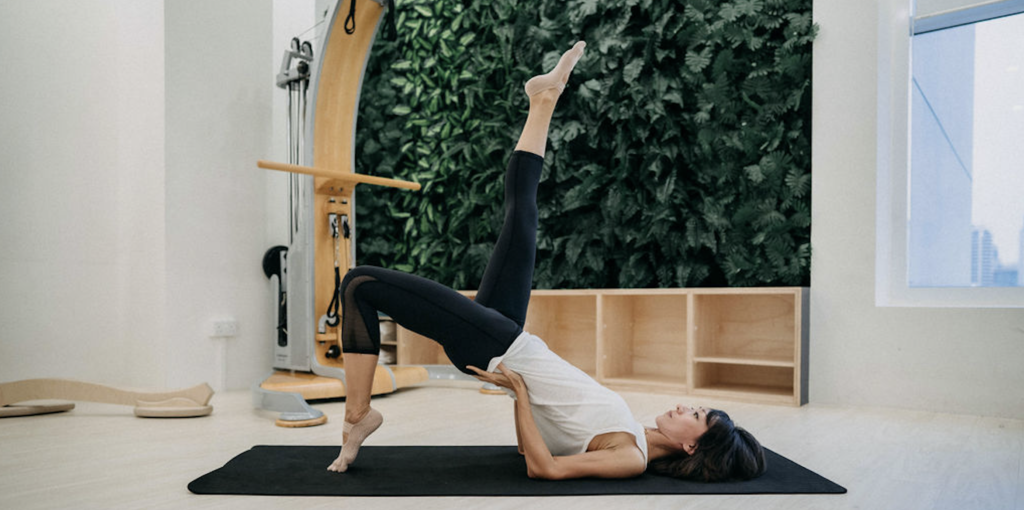
Lower Back & Hip Pain

Lower back and hip pain is extremely common. For some of us, this could be a simple ache that improves quickly. However, for others, it can be a much longer-term problem. These range from simple stiffness due to poor posture to more serious conditions like herniated discs and sciatica.
In this series, we begin to explain the most common causes of lower back and hip pain and over the next few weeks, we will publish exercises and self-massage technique videos to help relieve that tension so you can stand tall and pain-free!
Weak Core
We sometimes find clients who perform the ‘hundreds’ with full leg extension in Pilates complain about back pain. This is because their core is not strong enough and too much pressure is applied to the lower part of the spine (so we advise those who have a weaker core to use table-top legs).
Having a strong and healthy core is important for our health and posture. When your core is strong and working properly, you will have less back pain, better posture, and will move with more ease, endurance and a spring in your step!
The most common side effect of a weak core is back pain, and yet most people still don’t consider core strengthening as a way to address those problems. Your core’s job is to support your spine and act as the center from which all movement stems .
If those muscles are not properly conditioned – meaning, if they aren’t conditioned to engage when they are supposed to – your spine is at risk for being overworked, and muscular strain and tension are inevitable. The pain will most likely occur in your lower back, but can even occur in your neck, making simple tasks like bending, lifting, and walking totally miserable for you.
Check out our video with Breathe Instructor Deborah in our ‘Get To Know Your Core’ segment
Poor Ergonomics and Posture
Ergonomics can either be part of the problem or part of the solution in chronic pain, especially chronic lower back pain. Not taking care of your spine during the workday can lead to chronic back or neck pain—because that’s 8 hours of poor posture, slouching, muscle tension, straining to see the computer screen, etc.
However, ergonomics can also help you avoid some forms of chronic pain. If you make a conscious effort to practice good ergonomics every day, you can possibly prevent chronic muscle tension and back pain caused by poor posture, among other forms of chronic spinal pain.
If you already have chronic pain, good ergonomics may help control your pain and help you get through the work day. There’s lots of simple and effective ways to fix this and we have made a short video with Breathe instructor and physiotherapist Ashley to share some with you!
Muscle Or Tendon Strain
Repeated activities can put a strain on the muscles, tendons, and ligaments that support the hips. When they become inflamed due to overuse, they can cause pain and prevent the hip from working normally.
One of the most common complaints is hip flexor strains which can occur when the hip flexor muscles are pulled, strained, torn or injured. A range of activities may cause the condition with the chief symptom being sharp pain. Symptoms of hip flexor strain includes:
- sudden, sharp pain in the hip or pelvis after trauma to the area
- a cramping or clenching sensation in the muscles of the upper leg area
- the upper leg feeling tender and sore
- loss of strength in the front of the groin along with a tugging sensation
- muscle spasms in the hip or thighs
- inability to continue kicking, jumping, or sprinting
- reduced mobility and discomfort when moving, including limping
- discomfort and pain in the upper leg area, which feels constant
- swelling or bruising around the hip or thigh area
- tightness or stiffness after being stationary, such as after sleeping
A person’s hip flexors are engaged when they bring their knee up towards their torso. Hence, activities such as dancing, martial arts, or running are where hip flexors are put under the most strain. Athletes who use the hip flexors in their sport and training are more susceptible to hip flexor strain or injury that can cause the muscles to tear. In sports medicine, it is thought that many hip flexor wounds are associated with hamstring strains.
If you’re feeling your hips are tight and you need to release, check out our video where Breathe Instructor Rohini takes you through a series of stretches and Pilates exercises that will improve your hamstring flexibility and overall mobility.
Share — Facebook Twitter
 WHATSAPP
WHATSAPP


